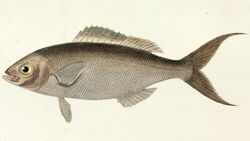Biology:Apsilus
| Apsilus | |
|---|---|

| |
| Apsilus fuscus | |
| Scientific classification | |
| Domain: | Eukaryota |
| Kingdom: | Animalia |
| Phylum: | Chordata |
| Class: | Actinopterygii |
| Order: | Perciformes |
| Family: | Lutjanidae |
| Subfamily: | Apsilinae |
| Genus: | Apsilus Valenciennes, 1830[1] |
| Type species | |
| Apsilus fuscus Valenciennes, 1830[1]
| |
| Synonyms[1] | |
|
Tropidinius Poey 1868 | |
Apsilus is a small genus of marine ray-finned fish, snappers belonging to the family Lutjanidae. The two species within the genus are native to the Atlantic Ocean,[2]
Characteristics
The two species within the genus Apsilus are medium-sized snappers with fusiform bodies, the body can be slender or relatively deep but these are robust fishes. The jaws are equipped with moderately sized teeth which are conical or bristle shaped and which are arranged in bands with the outer row enlarged. They have a continuous dorsal fin which is not notched where the spiny and soft-rayed parts meet. The dorsal fin has 10 spines and 9 or 10 soft rays while the anal fin has 3 spines and 8 soft rays. The dorsal and anal fins are lacking in scales while the caudal fin is scaled, the caudal fin may be forked or emarginate.[3]
Distribution
Apsilus fishes are found in the Atlantic Ocean, the African forktail snapper has been reported from the Indian Ocean[3] but these reports are questionable.[4]
Habitat and biology
Apsilus snappers inhabit waters with depths between 30 and 300 m (98 and 984 ft), typically over rocky substrates. They may be encountered as solitary fish or in aggregations and they feed on small fish, squid, benthic crustaceans and more sizeable zooplankton.[3]
Species
The following currently recognized species make up the genus Apsilus:[2]
- Apsilus dentatus Guichenot, 1853 (black snapper)
- Apsilus fuscus Valenciennes, 1830 (African forktail snapper)
Systematics and etymology
Apsilus was created in 1830 when the French zoologist Achille Valenciennes described A. fuscus from the Cape Verde Islands.[1] In 1980 when G. David Johnson designated the subfamily Apsilinae within the Lutjanidae he used Apsilus as its type genus.[5]
Apsilusis formed the word a meaning "not" and psilos meaning naked or bald, Valenciennes did not explain what this name alludes to but these fishes have scales on the caudal fin, but none of the other fins are scaled.[6]
References
- ↑ 1.0 1.1 1.2 1.3 Eschmeyer, William N.; Fricke, Ron; van der Laan, Richard, eds. "Genera in the family Lutjanidae". California Academy of Sciences. http://researcharchive.calacademy.org/research/ichthyology/catalog/fishcatget.asp?tbl=genus&family=Lutjanidae.
- ↑ 2.0 2.1 Froese, Rainer and Pauly, Daniel, eds. (2021). Species of Apsilus in FishBase. February 2021 version.
- ↑ 3.0 3.1 3.2 Gerald R. Allen (1985). FAO species catalogue Vol.6. Snappers of the world An annotated and illustrated catalogue of lutjanid species known to date. FAO Rome. pp. 18. ISBN 92-5-102321-2. http://www.fao.org/3/ac481e/ac481e06.pdf.
- ↑ Froese, Rainer and Pauly, Daniel, eds. (2021). "Apsilus fuscus" in FishBase. February 2021 version.
- ↑ Richard van der Laan; William N. Eschmeyer; Ronald Fricke (2014). "Family-group names of Recent fishes". Zootaxa 3882 (2): 001–230. doi:10.11646/zootaxa.3882.1.1. PMID 25543675. https://biotaxa.org/Zootaxa/article/view/zootaxa.3882.1.1/10480.
- ↑ Christopher Scharpf; Kenneth J. Lazara, eds (5 January 2021). "Order LUTJANIFORMES: Families HAEMULIDAE and LUTJANIDAE". The ETYFish Project Fish Name Etymology Database. Christopher Scharpf and Kenneth J. Lazara. https://etyfish.org/lutjaniformes/. Retrieved 4 May 2021.
Wikidata ☰ Q10416303 entry
 |

